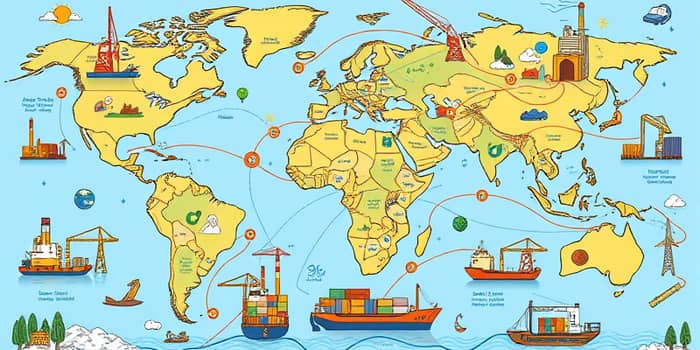The global flow of goods underpins nearly every sector of commerce, yet in 2025, it faces unprecedented volatility. From climate shocks to geopolitical friction, industries must adapt rapidly.
Major Supply Chain Risks
Supply chains in 2025 operate under a spectrum of hazards that threaten continuity and resilience. Leaders must recognize these risks to develop robust strategies.
- Climate-related disruptions dominate risk profiles, with 70% of weather-related events in 2024 caused by floods.
- Geopolitical instability continues to escalate, prompting firms to reevaluate sourcing corridors and partnerships.
- Cybercrime targets critical logistics systems, forcing enhanced digital security measures.
- Scarcity of rare metals disrupts manufacturing, as lockdowns and export controls tighten availability.
- Tariffs and trade restrictions reshape supply routes, with US import duties of up to 25% raising costs on electronics and semiconductors.
On average, disruptions lasting more than one month occur every 3.7 years, and 80% of organizations experienced at least one major interruption in the past year.
Statistical Overview
A clear-eyed view of performance metrics highlights both persistent challenges and emerging resilience.
Impact by Industry
Supply chain pressures reverberate differently across sectors, demanding tailored responses.
Manufacturing grapples with escalating raw material costs, complex regulatory requirements, and significant labor shortages. Nearly 62% of leaders identify workforce gaps as a major short-term hurdle, and 74% of firms are pouring investments into automation and Internet of Things solutions to bridge talent deficits.
Retail is contending with consumer price hikes of 3–5% on apparel, driven by a 10% duty on imported clothing, while also optimizing inventory management to prevent stockouts amid transport bottlenecks.
Electronics and Technology supply chains are migrating away from China toward Vietnam, Bangladesh, India, and South Korea, where tariff avoidance and diversified sourcing have increased South Korea’s US supply share to 5.47% in 2025. These shifts illustrate how companies reconfigure networks to mitigate up to 25% duty burdens.
Automotive manufacturers, reliant on rare earth elements, face acute vulnerability to export curbs. Strategies such as dual sourcing and strategic stockpiling are gaining traction.
Food and Agriculture sectors confront both climatic unpredictability and trade disruptions, contributing to the surge from 100 million to 343 million individuals facing food insecurity between 2020 and 2025.
Recent Trends Shaping Supply Chains
To counterbalance risk and cost pressures, organizations are adopting innovative models.
- Reshoring and Nearshoring for resilience—US firms shifting production closer to home saw a 10% drop in logistics emissions.
- Global supply base diversification spreads sourcing across regions to reduce dependency on any one nation.
- Digital transformation acceleration drives 82% of companies to increase IT budgets for AI, blockchain, and real-time visibility.
- Automation and IoT integration aims to alleviate labor shortages and improve operational agility.
- Sustainability imperatives elevate environmental compliance as 50% of consumers base trust on eco-friendly practices.
Strategic Responses for Robust Supply Chains
Effective mitigation demands a combination of technology, policy, and collaboration.
- Supplier diversification and multi-sourcing minimize the impact of localized disruptions and geopolitical shifts.
- Contingency planning and stock buffers ensure critical inventory remains accessible during extended disruptions.
- Investment in automation and digital tools enhances visibility and accelerates decision-making across complex networks.
- Strategic logistics partnerships provide scale, flexibility, and shared risk management capabilities.
Future Outlook and CEO Perspectives
Looking ahead, 71% of US CEOs plan to overhaul their supply chains within the next three to five years, focusing on trade unpredictability and sustained inflationary pressure. With 61% expecting continued low growth, the emphasis will be on balancing cost control with resilience.
Regulatory complexity remains a drag on operations—77% of executives cite compliance hurdles as a negative factor, and 31% have established new contingency frameworks in response to recent tariff changes.
Conclusion
In 2025, supply chain dynamics are defined by rapid adaptation to a convergence of climate, political, and technological forces. While disruptions persist, innovative strategies and digital investments are driving stronger, more agile networks. By embracing diversification, automation, and sustainability, industries can transform challenges into competitive advantage and secure reliable access to markets and customers in an ever-changing global economy.
References
- https://www.plantemoran.com/explore-our-thinking/insight/2023/03/top-supply-chain-issues-ranked
- https://www.dhl.com/global-en/delivered/global-trade/top-5-supply-chain-risks-in-2025.html
- https://www.supplychainbrain.com/blogs/1-think-tank/post/41852-how-tariffs-are-reshaping-global-supply-chains-in-2025
- https://tradeverifyd.com/resources/supply-chain-statistics
- https://procurementtactics.com/supply-chain-statistics/
- https://www.z2data.com/insights/most-destructive-supply-chain-challenges-2025-how-to-navigate
- https://www.averitt.com/blog/2025-supply-chain
- https://tax.thomsonreuters.com/blog/2025s-supply-chain-challenge-confronting-complexity-and-disruption-in-global-trade-tri/










